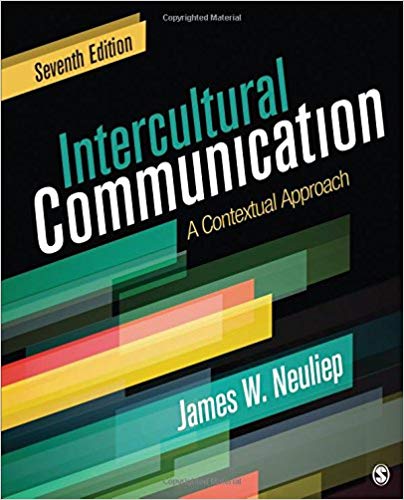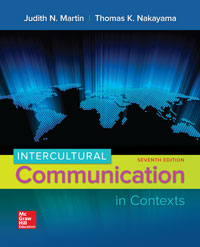Test Bank For Intercultural Communication A Contextual Approach 7th Edition by James W. Neuliep
Original price was: $95.00.$45.00Current price is: $45.00.
Digital item No Waiting Time Instant Download
ISBN: 9781506315133
Edition 7th Edition
Version US Edition
Author Neuliep
Release Date 2017
Publisher SAGE
Description
Test Bank For Intercultural Communication A Contextual Approach 7th Edition by James W. Neuliep
Instructor Resources Neuliep, Intercultural Communication, 7e SAGE Publishing, 2018
Chapter 1: The Necessity of Intercultural Communication
Multiple Choice
1. Communicating and establishing relationships with people from different cultures can lead to a number of benefits, including healthier communities, increased commerce, reduced conflict, and ______.
a. personal growth through tolerance
b. reduced illegal immigration
c. increased legal immigration
d. increased agenda-setting opportunities
Ans: A
Answer Location: Benefits of Intercultural Communication
Learning Objective: 1-1: Describe why intercultural communication is a necessity. Cognitive Domain: Knowledge
Difficulty Level: Easy
2. Who is generally recognized as the founder of the academic discipline we call intercultural communication?
a. Edward T. Hall
b. James W. Neuliep
c. James C. McCroskey
d. Arthur M. Schlesinger
Ans: A
Answer Location: The Study of Intercultural Communication
Learning Objective: 1-4: Explain the different contexts that make up the contextual model of intercultural communication.
Cognitive Domain: Knowledge Difficulty Level: Easy
3. Communication is considered a process because ______. a. it is contextual
b. it is always developing
c. it frequently stops and starts
d. it is verbal and nonverbal
Ans: B
Answer Location: The Nature of Human Communication
Learning Objective: 1-2: Define and discuss the nature of communication. Cognitive Domain: Comprehension
Difficulty Level: Medium
Instructor Resources Neuliep, Intercultural Communication, 7e SAGE Publishing, 2018
4. Communication is considered interactive and transactive because ______. a. it occurs between people
b. it is multidimensional
c. it is intrapersonal
d. it is flexible and adaptive
Ans: A
Answer Location: The Nature of Human Communication
Learning Objective: 1-2: Define and discuss the nature of communication. Cognitive Domain: Knowledge
Difficulty Level: Easy
5. A symbol can be defined as ______.
a. a natural part of that which it represents
b. a decoded message presenting something else
c. an arbitrarily selected and learned stimulus representing something else d. an encoded message representing something else
Ans: C
Answer Location: The Nature of Human Communication
Learning Objective: 1-2: Define and discuss the nature of communication. Cognitive Domain: Knowledge
Difficulty Level: Easy
6. Intentional communication occurs when ______.
a. two or more people perceive each other
b. two or more people consciously engage in interaction with each other
c. two or more people create nonverbal symbols representing something else d. two or more people use language to create symbols
Ans: B
Answer Location: The Nature of Human Communication
Learning Objective: 1-2: Define and discuss the nature of communication Cognitive Domain: Knowledge
Difficulty Level: Easy
7. There are at least five different contexts that influence intercultural communication, including the cultural context, the microcultural context, the environmental context, the sociorelational context, and the ______.
a. perceptual context
b. historical context c. personal context d. situational context Ans: A
Learning Objective: 1-4: Explain the different contexts that make up the contextual model of intercultural communication.
Cognitive Domain: Knowledge
Difficulty Level: Easy
Instructor Resources Neuliep, Intercultural Communication, 7e SAGE Publishing, 2018
8. Culture can be defined as an accumulated pattern of ______. a. contexts, situations, and environments
b. processes, dynamics, and intentions
c. languages, schools, and laws
d. values, beliefs, and behaviors
Ans: D
Answer Location: A Contextual Model of Intercultural Communication
Learning Objective: 1-4: Explain the different contexts that make up the contextual model of intercultural communication.
Cognitive Domain: Knowledge
Difficulty Level: Easy
9. The verbal and nonverbal symbols with which members of a culture communicate are ______. a. taught informally
b. shared universally
c. culture-bound
d. universally expressed
Ans: C
Answer Location: Verbal and Nonverbal Symbol Systems Learning Objective: 1-3: Define and discuss the nature of culture. Cognitive Domain: Knowledge
Difficulty Level: Easy
10. The environmental context in the model of intercultural communication includes the ______. a. intrinsic and extrinsic cultural context
b. the intimate sociorelationships that people develop in the culture
c. the physical geography, architecture, landscape and climate of the culture
d. the landmark institutions of a culture (e.g., schools, malls, ballparks)
Ans: C
Answer Location: A Contextual Model of Intercultural Communication
Learning Objective: 1-4: Explain the different contexts that make up the contextual model of intercultural communication.
Cognitive Domain: Knowledge Difficulty Level: Easy
11. Increased uncertainty during intercultural communication is typically associated with ______.
a. increased use of verbal symbols
b. increased use of nonverbal symbols
c. decreased volume of voice
d. increased anxiety
Ans: D
Answer Location: Intercultural Communication and Uncertainty
Learning Objective: 1-4: Explain the different contexts that make up the contextual model of intercultural communication.
Cognitive Domain: Comprehension
Difficulty Level: Medium
12. Competently interacting with someone from a different culture requires a certain amount of knowledge, motivation, and ______.
a. perception
b. skill
c. sensitivity
d. culture
Ans: B
Answer Location: Intercultural Communication Apprehension
Learning Objective: 1-4: Explain the different contexts that make up the contextual model of intercultural communication.
Cognitive Domain: Comprehension Difficulty Level: Medium
13. An interculturally competent communicator is ______. a. usually a person from two or more cultures
b. a person who speaks more than one language
c. sensitive to the expectations of the context
d. in a novel and unusual situation
Ans: C
Answer Location: Intercultural Communication Apprehension
Learning Objective: 1-7: Describe why intercultural communication competence is a necessity. Cognitive Domain: Comprehension
Difficulty Level: Medium
14. In addition to their shared values and beliefs, the members of a particular culture ______. a. history
b. ethnic heritage
c. racial background
d. zip code
Ans: A
Answer Location: A Contextual Model of Intercultural Communication
Learning Objective: 1-4: Explain the different contexts that make up the contextual model of intercultural communication.
Cognitive Domain: Knowledge
Difficulty Level: Easy





Be the first to review “Test Bank For Intercultural Communication A Contextual Approach 7th Edition by James W. Neuliep”